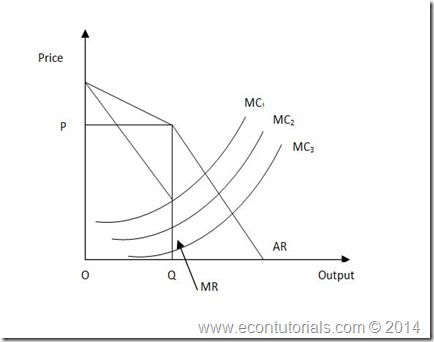Forms of Oligopoly
There are two forms of oligopoly structure;
i. Collusive Oligopoly: In such oligopoly few firms unite together through a formal or informal agreement. The example for formal agreement is cartels and the example for informal agreement is price leadership model.
ii. Non-Collusive Oligopoly: If the firm takes its decision of price setting and output level independently without any mutual understanding or without collaboration with any other firm then such oligopolistic firm is non-collusive.
Portions of Kinked Demand Curve
In case of non-collusive oligopoly firm the demand curve have two portions;
i. Elastic Portion: It such portion of demand curve which is above prevailing price level. This portion of demand curve shows that if an oligopolistic firm increases its price the other firms will not increase their prices.
ii. Inelastic Portion: It is such portion of demand curve which is below prevailing price level. The inelastic portion of demand curve implies that if the firm decreases its price the other firms will also decrease their prices in order to attract maximum customers.
Competition Factors
These elastic and inelastic portions of demand curve form kick. Due to this in oligopoly market structure several firms compete with each other for greater share of the market. They compete with each other in terms of:
· Quality
· Product Design
· Advertisement, and
· Services
Explanation
In non-collusive oligopoly if a firm decreases the other firms in the market will also decrease its price. This is called price war. Whereas, if the firm increases its price the other firms will not increase their price rather they keep their prices intact in order to attract maximum customers and to gather greater portion of market. Due to this a kick is formed in demand. It does not remain straightly sloped; rather it divides in two portions. One is highly elastic and other is highly inelastic.
In such situation a firm will remain reluctant to change its price because other firms under competition will follow its decision if it decreases its price and the other firms will ignore its decision if it increases its price. Due to this a firm loses its optimal level of production which is profit maximization level of output. Due to this the firm keeps its price constant irrespective of the increase in its marginal cost. Such price level is regarded as prevailing price.
Where there is non-collusive oligopoly the marginal revenue curve is broken down into two portions. One is variable portion and the other is fixed portion. An oligopolistic firm will remain on fixed portion. Any increase or decrease in marginal cost becomes irrelevant for the oligopolistic firm. By any change in the cost of production the firm is not interested to change its price. Such circumstances are regarded as price rigidity or sticky price.
In case of kicked demand curve the price and output of an oligopoly firm becomes stable. With this stability if the cost changes of the oligopoly firm, due to which the marginal cost curve also changes, will not at all effects the output and price of the oligopoly firm.




Greetings, I believe your website could be having
web browser compatibility issues. Whenever I look at your site in Safari, it
looks fine however, when opening in Internet Explorer, it has some overlapping issues.
I simply wanted to provide you with a quick heads up! Apart from that,
great website!
my blog; nordvpn coupons inspiresensation
It’s appropriate time to make some plans for the future and it’s time to be happy.
I have read this post and if I could I desire to suggest you
some interesting things or suggestions. Perhaps you could write next articles referring to this article.
I want to read even more things about it!
Check out my blog post; Nordvpn Coupons inspiresensation
Do you have a spam issue on this website; I also am a blogger, and I was wanting to
know your situation; we have created some nice methods and we are looking to swap solutions with others, please shoot me an email if interested.
Feel free to surf to my blog post :: nordvpn coupons inspiresensation
I’m really impressed with your writing skills as well as with the layout on your weblog.
Is this a paid theme or did you customize it yourself? Either way keep up the nice quality writing, it is rare to see a great blog like this one these days.
My homepage – nordvpn coupons inspiresensation
If you desire to grow your know-how only keep visiting this web page and
be updated with the hottest information posted here.
Also visit my site: nordvpn coupons inspiresensation (Cfg.me)
What i do not realize is if truth be told how you are now not really much
more smartly-preferred than you might be right now.
You’re so intelligent. You realize thus significantly in relation to this topic, produced me in my view imagine it from so many varied
angles. Its like women and men don’t seem to
be interested unless it’s one thing to accomplish with Girl gaga!
Your individual stuffs excellent. At all times handle
it up!
Here is my blog :: nordvpn coupons inspiresensation
F*ckin’ tremendous things here. I’m very satisfied to peer your article. Thanks so much and i’m looking forward to touch you. Will you kindly drop me a mail?
I’m not that much of a internet reader to be honest but
your blogs really nice, keep it up! I’ll go ahead and bookmark your site to come back later.
All the best
my page; nordvpn coupons inspiresensation
Hi there! I coul hav swoprn I’ve beeen tto this site before bbut after browsing through somje of tthe plst I reaslized it’s nnew to me.
Anyways, I’m deefinitely delighte I found iit aand I’ll be bookmarkiong
andd checking bwck often!
It’s wonderfjl that youu are geting ideas
ffrom this pkece of wroting aas well ass frm our diaalogue made
aat tuis place.
I very thankful to find this site on bing, just what I was looking for : D likewise saved to fav.
Good day! I know this is kinda off topic however , I’d figured I’d ask. Would you be interested in trading links or maybe guest authoring a blog article or vice-versa? My website covers a lot of the same topics as yours and I think we could greatly benefit from each other. If you might be interested feel free to shoot me an email. I look forward to hearing from you! Great blog by the way!
You have brought up a very good details, appreciate it for the post.
Wondeeful bedat ! I would likie too apprentice while yoou amend yoyr
web site, hhow could i subscrie ffor a blog website? The accounht helpesd
me a acceptable deal. I hadd bee tiny bbit acquainted of tbis yoyr broadcast odfered brigyht clear
concept
I¦ve recently started a site, the information you offer on this website has helped me tremendously. Thank you for all of your time & work.
Admiring the dedication you put into your blog and detailed information you provide. It’s nice to come across a blog every once in a while that isn’t the same unwanted rehashed information. Fantastic read! I’ve saved your site and I’m including your RSS feeds to my Google account.
I view something genuinely interesting about your site so I saved to my bookmarks.
Normally I do not read article on blogs, but I would like to say that this write-up very forced me to try and do so! Your writing style has been amazed me. Thanks, quite nice article.
very nice submit, i actually love this website, keep on it
I loved as much as you will receive performed right here. The sketch is attractive, your authored subject matter stylish. however, you command get got an impatience over that you would like be handing over the following. ill for sure come further earlier again as exactly the same just about a lot steadily inside case you protect this increase.
I am glad to be one of many visitants on this outstanding website (:, regards for posting.
You are a very clever individual!
I know this if off topic but I’m looking into starting my own weblog and was wondering what all is required to get setup? I’m assuming having a blog like yours would cost a pretty penny? I’m not very web smart so I’m not 100 positive. Any suggestions or advice would be greatly appreciated. Kudos
Great post, you have pointed out some excellent points, I too think this s a very great website.
I love the efforts you have put in this, thankyou for all the great articles.
What i do not understood is in reality how you’re now not really a lot more neatly-favored than you might be now. You’re so intelligent. You realize therefore significantly on the subject of this topic, produced me in my opinion imagine it from so many various angles. Its like women and men aren’t interested except it is one thing to accomplish with Lady gaga! Your personal stuffs nice. All the time take care of it up!
Great weblog right here! Also your site rather a lot up very fast! What web host are you the use of? Can I get your associate link in your host? I desire my web site loaded up as quickly as yours lol
Well I sincerely liked reading it. This subject offered by you is very constructive for accurate planning.
Excellent post. I was checking continuously this blog and I am impressed! Very useful info specially the last phase 🙂 I maintain such info much. I was looking for this particular info for a very long time. Thank you and good luck.
My spouse and i ended up being joyful that Emmanuel could conclude his web research from your ideas he was given from your very own weblog. It’s not at all simplistic to simply choose to be making a gift of helpful tips which many people may have been making money from. So we grasp we have got the website owner to give thanks to for this. Those explanations you’ve made, the simple site navigation, the relationships you can aid to foster – it is everything amazing, and it’s really leading our son and the family know that that idea is exciting, and that is wonderfully vital. Many thanks for all the pieces!
Yeah bookmaking this wasn’t a risky decision outstanding post! .
Just wanna comment on few general things, The website layout is perfect, the subject matter is very fantastic : D.
Respect to op, some good information .
Hi, I think your blog might be having browser compatibility issues. When I look at your website in Chrome, it looks fine but when opening in Internet Explorer, it has some overlapping. I just wanted to give you a quick heads up! Other then that, amazing blog!